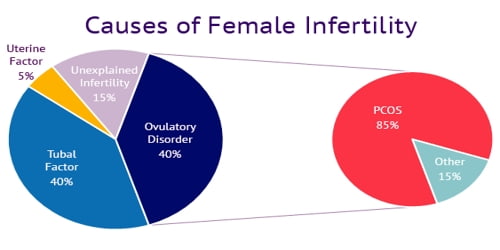Female Infertility
Definition: Female infertility refers to infertility in female humans. Infertility is defined as trying to get pregnant (with frequent intercourse) for at least a year with no success. An estimated 10 to 18 percent of couples have trouble getting pregnant or having a successful delivery. Infertility is caused by many sources, including nutrition, diseases, and other malformations of the uterus. Infertility affects women from around the world, and the cultural and social stigma surrounding it varies.
An infertility diagnosis is given to a couple that has been unsuccessful in efforts to conceive over the course of one full year. When the cause of infertility exists within the female partner, it is referred to as female infertility. Female infertility factors contribute to approximately 50% of all infertility cases, and female infertility alone accounts for approximately one-third of all infertility cases.
Female infertility causes can be difficult to diagnose. There are many available treatments, which will depend on the cause of infertility. Many infertile couples will go on to conceive a child without treatment. After trying to get pregnant for two years, about 95 percent of couples successfully conceive.
According to the World Health Organization (WHO), infertility can be described as the inability to become pregnant, maintain a pregnancy, or carry a pregnancy to live birth. A clinical definition of infertility by the WHO and ICMART is “a disease of the reproductive system defined by the failure to achieve a clinical pregnancy after 12 months or more of regular unprotected sexual intercourse.”

Causes, Signs, and Symptoms of Female Infertility: Causes or factors of female infertility can basically be classified regarding whether they are acquired or genetic, or strictly by location. The most common causes of female infertility include problems with ovulation, damage to fallopian tubes or uterus, or problems with the cervix. Age can contribute to infertility because as a woman ages, her fertility naturally tends to decrease.
Female infertility can be caused by:
- ovulation problems
- polycystic ovary syndrome
- problems with the fallopian tubes
- problems with the uterus
- endometriosis.
Abnormal cervical mucus can also cause infertility. Abnormal cervical mucus can prevent the sperm from reaching the egg or make it more difficult for the sperm to penetrate the egg.
Certain factors may put people at higher risk of infertility, including:
- Age
- Weight
- Sexual history
- Smoking
- Alcohol
The primary symptom of infertility is difficulty getting pregnant. A menstrual cycle that’s too long (35 days or more), too short (less than 21 days), irregular or absent can mean that women are not ovulating. There may be no other outward signs or symptoms.
Any of the following problems may cause infertility:
- Infrequent ovulation
- Scarring in the fallopian tubes
- A previous surgery
- Abnormalities in the shape or lining of the uterus, such as fibroid tumors or uterine polyps.
- Uterine infections
- Miscarriages
- Abortions
- Surgical procedures such as a dilation and curettage (D&C)
The doctor may also want to begin testing or treatment right away if women or her partner has known fertility problems, or if they have a history of irregular or painful periods, pelvic inflammatory disease, repeated miscarriages, prior cancer treatment, or endometriosis.

Diagnosis and Treatment of Female Infertility: Diagnosis of infertility begins with a medical history and physical exam. Healthcare providers may use one or more of the following tests/exams to evaluate fertility:
- A urine or blood test to check for infections or a hormone problem, including thyroid function
- Pelvic exam and breast exam
- A sample of cervical mucus and tissue to determine if ovulation is occurring
- Laparoscope inserted into the abdomen to view the condition of organs and to look for blockage, adhesions or scar tissue.
- HSG, which is an x-ray used in conjunction with a colored liquid inserted into the fallopian tubes making it easier for the technician to check for blockage.
- Hysteroscopy uses a tiny telescope with a fiber light to look for uterine abnormalities.
- Ultrasound to look at the uterus and ovaries. Maybe done vaginally or abdominally.
- Sonohystogram combines an ultrasound and saline injected into the uterus to look for abnormalities or problems.
Usually, reproductive endocrinology & infertility medical practices do not see women for general maternity care. The practice is primarily focused on helping their women to conceive and to correct any issues related to recurring pregnancy loss.
Infertility treatment depends on the cause, patient’s age, how long they have been infertile and personal preferences. Because infertility is a complex disorder, treatment involves significant financial, physical, psychological and time commitments. Treatments can either attempt to restore fertility through medication or surgery or help them get pregnant with sophisticated techniques.
Treatment options for female infertility depend on the cause, but may include:
- surgery
- ovulation induction (using hormone therapy)
- assisted reproductive technologies (ART) including in vitro fertilization (IVF).
Infertility may be associated with infrequent or absent ovulation. This often can be treated with hormone medications. These are called fertility drugs. All fertility medications have potential side effects. And they can cause multiple babies in one pregnancy. Most fertility treatments require the supervision of a fertility specialist.
Information Source:
















